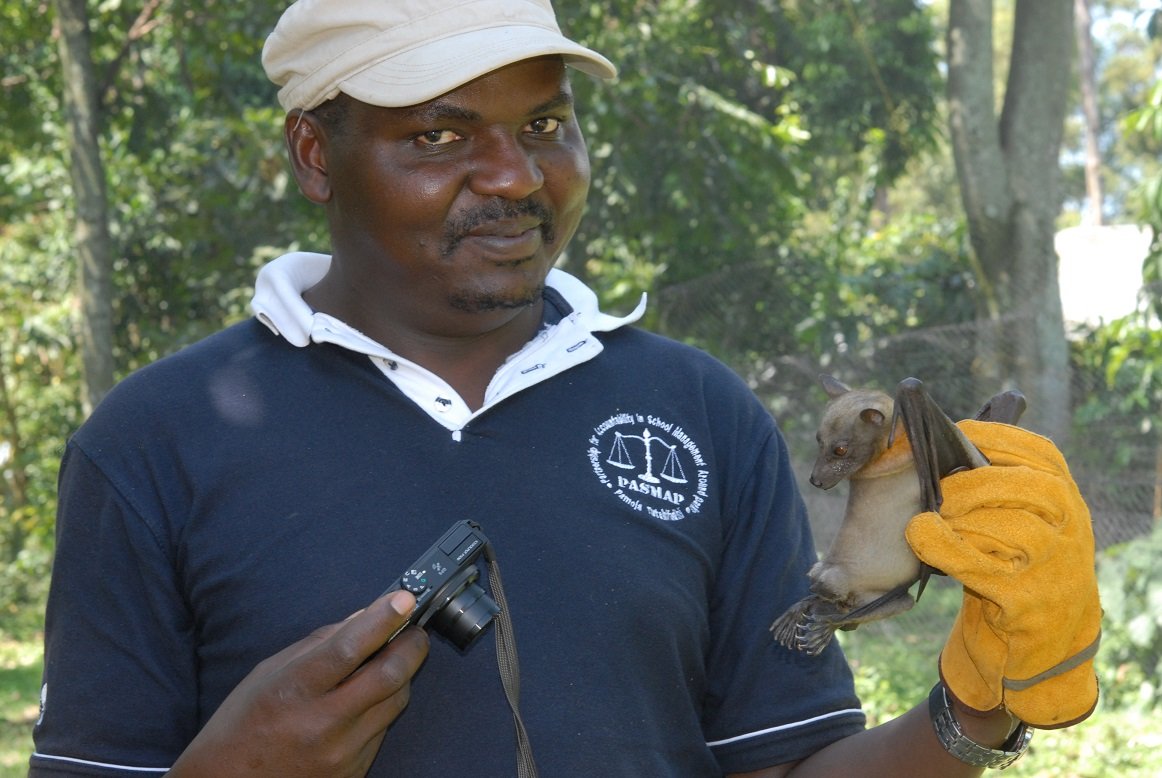|
Cycle 8 (2019 Deadline)
Distribution and species diversity of bats (Mammalia: Chiroptera) in Kenya
PI: Paul Webala (paul.webala@gmail.com), Maasai Mara University
U.S. Partner: Dawn Zimmerman, The Smithsonian Institution
Project Dates: January 2020 - June 2021
Project Overview
 | | PI Paul Webala collects data on local bat species (photo courtesy of Dr. Webala). |
In the face of unprecedented population declines in many wildlife species, monitoring changes in ecological communities is critically important for conservation planning and decision making. Bats (Mammalia: Chiroptera), with approximately 1,400 species, are the second-largest mammalian group on earth. They are also ideal biodiversity and environmental health indicators, as they have a wide range of ecological traits and tolerances to environmental variables, playing key roles in ecosystems. Since many bat species use sound to detect, localize, and classify objects, they can be monitored remotely and non-invasively by acoustic sensors. Acoustic monitoring is therefore a useful conservation tool to monitor anthropogenic effects on biodiversity. However, the paucity of local call reference libraries presents a major challenge to monitoring bats in tropical, megadiverse regions.
Kenya is home to more than 100 bat species, but despite the high diversity, they have not been systematically surveyed. In addition, more than 20% of the species are endangered and severely threatened due to anthropogenic drivers (e.g., habitat loss, climate change). The PI and his colleagues surveyed select Kenyan preserves and remote unsampled areas to collect biological samples and record vocalizations to speciate the bats.
Final Summary of Project Activities
The PEER team used a diversity of techniques in field collections, using mist nets, hand nets, and harp traps in different situations. Both mist nets and harp traps are useful in identifying areas used by bats in foraging or commuting. The researchers also used hand nets in caves, mines, tunnels, and dwellings to capture bats at roosts. The latter method was particularly informative, as it shed light on the bats’ social groupings, as well as their roosting preferences.
They routinely recorded echolocation calls from insectivorous bats. Calls were collected by releasing newly captured bats into a portable flight chamber and recording their ultrasonic calls as they flew around the chamber, looking for an exit. Echolocation calls were also recorded as bats were released into the wild and flew around. Other species families (e.g., Rhinolophidae) were recorded using hand-held bats because the "resting frequency" of these stationary individuals varies very little within a sequence, making hand-held calls best suited for frequency comparisons between individuals or populations.
Over the course of the project, they recorded more than 2,400 bats of 62 species. All ten echolocating bat families of Kenya are represented in the records, which will form the foundation of a national call library. The researchers also collected thousands of samples for disease surveillance, including blood, oral swabs, rectal swabs (or feces), urine, and external parasites. They also documented the myriad mites, ticks, fleas, bat flies, and bat bugs on the bats—in all, nearly 3,000 sets of parasites were collected and distributed to specialists. The team extracted prey DNA from fecal samples from 91 different species, and despite the lack of funding for immediate analysis, these samples currently constitute a sampled study of trophic habits.
The team also collected duplicate tissue samples, typically muscle but also wing biopsies, either flash frozen in liquid nitrogen or preserved in ethanol to aid genetic studies. Skulls were later extracted from the carcasses and cleaned to allow osteology and dentition analyses; it should be noted that this preparation preserved for study the highly variable soft-part anatomy of bats' nose-leaves, ears, lips, and chins, which vary due to their use in echolocation and intraspecific communication.
The PEER team presented their findings at several conferences, including the 2022 American Society of Mammalogists and the 2023 African Small Mammal Symposium. Many early-career students and assistants gained invaluable training and experience working with bats during the project cycle, some of them for the first time in their lives.
The team received nearly $250,000 in additional grants from two projects of the National Geography Society for continuing this work. A new species of Horseshoe Bat, Webala's Horseshoe Bat (Rhinolophus webalai) from Kenya, has been named after the PI in recognition of his important contributions as a field biologist, prolific author, conservation leader, and mentor to the next generation of African bat biologists. Going forward, the PEER team is working with Kate Jones at the University College London to develop algorithms that will form the basis of an automated acoustic call library for Kenya's diverse bat species.
Publication
J. Kamau, K. Ergunay, P.W. Webala, S.A. Justi, B.P. Bourke, M.W. Kamau, J. Hassell, M.N. Chege, D.K. Mwaura, C. Simiyu, S. Kibiwot, S. Onyuok, L. Caicedo-Quiroga, T. Li, D.M. Zimmerman, and Y.-M. Linton. 2022. A Novel Coronavirus and a Broad Range of Viruses in Kenyan Cave Bats. Viruses 14(12): 2820. https://doi.org/10.3390/v14122820
Back to PEER Cycle 8 Grant Recipients
|
|
|
|




